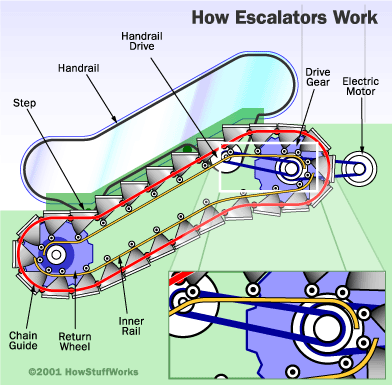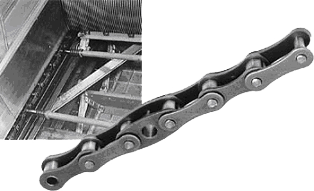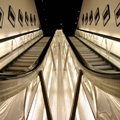APPENDIX A - History and Mechanics
A History
In 1899, Charles D. Seeberger joined the Otis Elevator company, bringing with him the name escalator (which was created by joining scala, which is Latin for steps, with elevator). The Seeberger-Otis union produced the first step-type escalator made for public use, and it was installed at the Paris Exhibition of 1900.

The Landing
The floor plates are level with the finished floor and are either hinged or removable to permit access to the machine spaces under them.
The comb plate is the piece between the stationary landing and the moving step. It slants down slightly so that the comb teeth fit between the cleats on the steps. The front edges of the comb teeth are below the surface of the cleats.
The Truss
The truss is the mechanical structure that bridges the space between the lower and upper landings. The truss is basically a hollow box made up of two side sections joined together with transverse braces across the bottom and just below the top.
The Tracks
 The track system is built into the truss to guide the step chain, which pulls the steps through an endless loop. There are two tracks: one for the front of the step (called the step-wheel track) and one for the trailer wheel of the step (called the trailer-wheel track). The relative position of these tracks causes the steps to appear from under the comb plate to form a staircase, and disappear back into the truss.
The track system is built into the truss to guide the step chain, which pulls the steps through an endless loop. There are two tracks: one for the front of the step (called the step-wheel track) and one for the trailer wheel of the step (called the trailer-wheel track). The relative position of these tracks causes the steps to appear from under the comb plate to form a staircase, and disappear back into the truss.
Construction and Features
In escalators, the steps are installed about every 400 mm, however, widths and heights are different. The tensile strength of step chains ranges from 6 to 30 tons. The 9-ton type and 15-ton type are most common. The steps themselves are either 24, 32, or 40 inches wide.
APPENDIX B - Power Genius Motor (.XLS)
Cashflow Calculation for the Power Genius Motor
APPENDIX C - COOL TOOLS (.PDF)
COOL TOOLS - OTIS TEAM Case Study
APPENDIX D - Presentation (.PPT)


